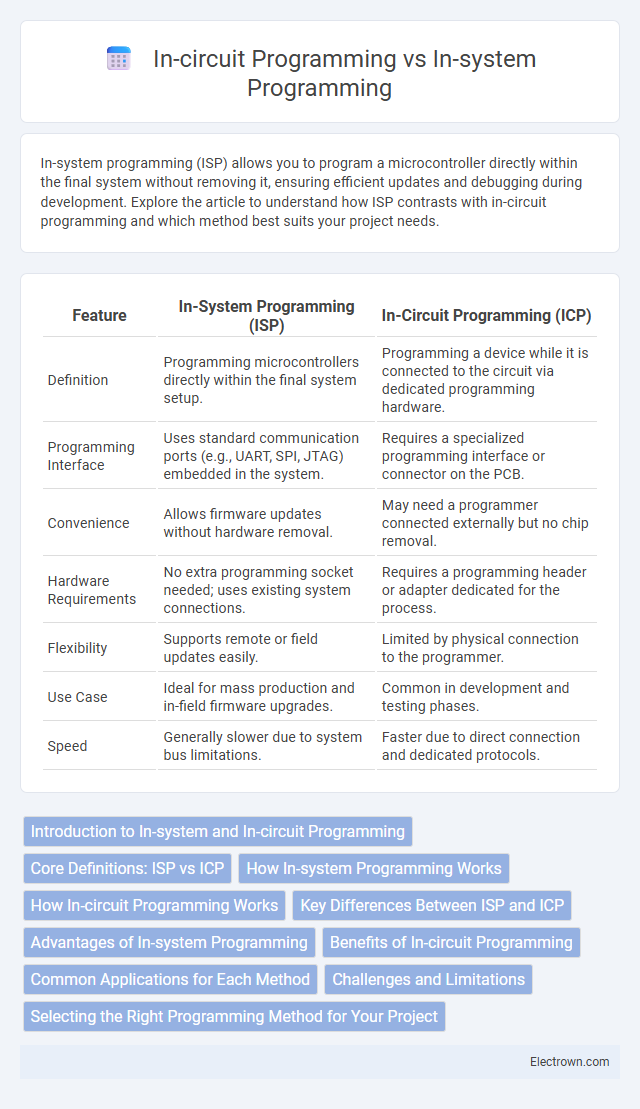In-system programming (ISP) allows you to program a microcontroller directly within the final system without removing it, ensuring efficient updates and debugging during development. Explore the article to understand how ISP contrasts with in-circuit programming and which method best suits your project needs.
Table of Comparison
| Feature | In-System Programming (ISP) | In-Circuit Programming (ICP) |
|---|---|---|
| Definition | Programming microcontrollers directly within the final system setup. | Programming a device while it is connected to the circuit via dedicated programming hardware. |
| Programming Interface | Uses standard communication ports (e.g., UART, SPI, JTAG) embedded in the system. | Requires a specialized programming interface or connector on the PCB. |
| Convenience | Allows firmware updates without hardware removal. | May need a programmer connected externally but no chip removal. |
| Hardware Requirements | No extra programming socket needed; uses existing system connections. | Requires a programming header or adapter dedicated for the process. |
| Flexibility | Supports remote or field updates easily. | Limited by physical connection to the programmer. |
| Use Case | Ideal for mass production and in-field firmware upgrades. | Common in development and testing phases. |
| Speed | Generally slower due to system bus limitations. | Faster due to direct connection and dedicated protocols. |
Introduction to In-system and In-circuit Programming
In-system programming (ISP) allows you to program microcontrollers or memory devices directly within the system using a dedicated interface, without removing the chip from the circuit board. In-circuit programming (ICP) similarly enables programming of devices while embedded in the circuit but often refers specifically to programming via boundary scan or JTAG interfaces, providing test and debug capabilities. Both methods streamline development and repair processes by simplifying firmware updates and reducing hardware handling risks.
Core Definitions: ISP vs ICP
In-system Programming (ISP) involves programming a microcontroller or memory device directly within the finished system, allowing firmware updates without removal from the circuit board. In-circuit Programming (ICP) refers specifically to programming devices while they are mounted on a circuit, using dedicated programming interfaces like JTAG or ICSP to enable real-time debugging and testing. Both ISP and ICP eliminate the need for device removal but ICP emphasizes debugging capabilities alongside programming, whereas ISP focuses primarily on firmware reprogramming in the operational environment.
How In-system Programming Works
In-system Programming (ISP) allows microcontrollers to be programmed directly within the final circuit, using dedicated programming pins or interfaces without removing the chip from the board. It operates by sending programming commands through protocols like SPI, JTAG, or UART, enabling memory byte-level modifications while the device remains powered and functional. ISP facilitates rapid firmware updates and debugging, enhancing production efficiency and reducing hardware handling risks compared to traditional programming methods.
How In-circuit Programming Works
In-circuit programming (ICP) enables direct programming of a microcontroller or programmable device while it remains embedded in the system, utilizing a special interface such as JTAG or ICSP. The programmer connects to dedicated pins on the device, allowing firmware updates without removal, which simplifies development and debugging. Your ability to reprogram devices in situ reduces downtime and enhances flexibility during product testing and maintenance.
Key Differences Between ISP and ICP
In-system programming (ISP) enables microcontrollers to be programmed after installation on a PCB, allowing firmware updates without removing the chip, while in-circuit programming (ICP) refers broadly to programming directly through the circuit connections. ISP typically uses dedicated programming interfaces like SPI or JTAG, providing convenience and reduced handling risk, whereas ICP may involve different protocols depending on the hardware setup. Key differences include ISP's focus on seamless, post-assembly firmware updates versus ICP's general approach to programming chips embedded in a circuit, with ISP offering a standardized, reliable method for ongoing device maintenance.
Advantages of In-system Programming
In-system programming (ISP) enables direct firmware updates on microcontrollers embedded in a complete system, eliminating the need for device removal and reducing production downtime. ISP supports faster development cycles by allowing quick debugging and reprogramming through standard interfaces like JTAG or SPI. This method enhances flexibility and cost-efficiency in manufacturing and maintenance compared to in-circuit programming (ICP), which often requires additional programming hardware.
Benefits of In-circuit Programming
In-circuit programming (ICP) allows you to program microcontrollers directly on the assembled circuit board, eliminating the need for separate programming devices and reducing production time. This approach enables quick firmware updates and debugging without removing the chip, improving development efficiency and maintenance convenience. ICP enhances flexibility and cost-effectiveness in your embedded system projects by streamlining the programming process.
Common Applications for Each Method
In-system programming (ISP) is commonly used for microcontrollers embedded within finished products, enabling firmware updates without removing the chip from the device, making it ideal for consumer electronics and automotive systems. In-circuit programming (ICP) is often applied during the manufacturing and testing phases, programming microcontrollers directly on the development board or prototype, crucial for industrial automation and hardware debugging. Both methods facilitate efficient firmware deployment but serve distinct phases of product development and maintenance.
Challenges and Limitations
In-system programming (ISP) faces challenges such as restricted access to the microcontroller due to limited pin availability and potential interference from other on-board components, which can complicate debugging and increase programming time. In-circuit programming (ICP) struggles with issues like signal integrity and voltage level mismatches caused by the connected circuitry, often requiring careful design considerations to ensure reliable programming. Your choice between ISP and ICP should weigh these limitations against the specific hardware architecture and development environment to optimize programming efficiency.
Selecting the Right Programming Method for Your Project
Selecting the right programming method for your project depends on factors such as access to the microcontroller, development stage, and hardware complexity. In-system programming (ISP) enables programming the device within the final system setup, ideal for limited space and frequent updates. In-circuit programming (ICP) offers direct access to the microcontroller through dedicated pins, suitable for initial development and debugging phases where easy reprogramming and testing are critical.
In-system Programming vs In-circuit Programming Infographic

 electrown.com
electrown.com